Impact of Increased Vertical Resolution in WACCM on the Climatology of Major Sudden Stratospheric Warmings
Abstract
1. Introduction
2. Dataset and Methodology
3. Basic SSW Characteristics
4. Analysis of the Monthly Distribution of SSWs
5. Polar Cap Temperature
6. Differences in Monthly Variability of Winds
7. Eliassen-Palm Flux and Mesoscale Gravity Wave Drag (GWD)
8. Conclusions
Author Contributions
Funding
Data Availability Statement
Acknowledgments
Conflicts of Interest
Appendix A
| (km) | |||||
|---|---|---|---|---|---|
| Models | References | Model | WACCM_hvr | Model Top | |
| 1 | ACCESS1.0 | [25,75] | 1.03 | 0.49 | 39 km |
| 2 | ACCESS1.3 | [25,75] | 1.03 | 0.49 | 39 km |
| 3 | ACCESS CCM | [26] | 1.40 | 0.75 | 84 km |
| 4 | AMTRAC | [76] | 1.58 | 0.74 | 0.02 hPa |
| 5 | CanESM2 | [25,75,77] | 1.98 | 0.56 | 0.5 hPa |
| 6 | CanESM5 | [78] | 0.99 | 0.53 | 1 hPa |
| 7 | CCSM4 | [25,75,79] | 1.59 | 0.51 | 2.194 hPa |
| 8 | CCSRNIES-MIROC 3.2 | [26] | 2.33 | 0.73 | 0.012 hPa |
| 9 | CESM2 | [78] | 1.25 | 0.50 | 40 km |
| 10 | CESM2-WACCM | [78] | 2.14 | 1.14 | 150 km |
| 11 | CMAM | [26,80] | 1.41 | 0.85 | 0.0006 hPa |
| 12 | CMCC-CESM | [25,75,77,81] | 1.82 | 0.67 | 0.04 hPa |
| 13 | CMCC-CM | [25,75] | 1.04 | 0.49 | 10 hPa |
| 14 | CMCC-CMS | [25,75,77] | 0.85 | 0.73 | 0.01 hPa |
| 15 | CNRM-CCM | [26] | 1.40 | 0.75 | 84 km |
| 16 | CNRM-CM5 | [25,75,79] | 1.04 | 0.67 | 10 hPa |
| 17 | CNRM-ESM2-1 | [78] | 0.89 | 0.73 | 0.01 hPa |
| 18 | EMAC-L47 | [26] | 1.71 | 0.73 | 0.01 hPa |
| 19 | EMAC-L90 | [26] | 0.89 | 0.73 | 0.01 hPa |
| 20 | FVGCM | [30] | 1.46 | 0.73 | 0.01 hPa |
| 21 | GEOS-CCM | [26] | 1.12 | 0.73 | 0.01 hPa |
| 22 | GFDL-CM3 | [25,75,77,79,81] | 1.68 | 0.73 | 0.01 hPa |
| 23 | GFDL-CM4 | [78] | 1.47 | 0.53 | 1 hPa |
| 24 | GISS-E2-R | [79] | 1.61 | 0.63 | 0.1 hPa |
| 25 | GISS-E2-H | [79] | 1.61 | 0.63 | 0.1 hPa |
| 26 | GFDL-CM4 | [78] | 0.90 | 0.80 | 0.002 hPa |
| 27 | GISSL53 | [30] | 1.73 | 0.80 | 0.002 hPa |
| 28 | HadCM3 | [75,79] | 1.70 | 0.49 | 10 hPa |
| 29 | HadGEM2-CC | [25,75,77,79,81] | 1.40 | 0.75 | 84 km |
| 30 | HadGEM2-ES | [79] | 1.05 | 0.50 | 40 km |
| 31 | HadGEM3-ES | [26,82] | 1.00 | 0.76 | 85 km |
| 32 | HadGEM3-GC31-LL | [78] | 1.00 | 0.76 | 85 km |
| 33 | INM-CM5-0 | [78] | 0.82 | 0.60 | 0.20 hPa |
| 34 | IPSL-CM5A-LR | [25,75,77,79,81,83] | 1.82 | 0.67 | 0.04 hPa |
| 35 | IPSL-CM5A-MR | [25,75,77,79] | 1.82 | 0.67 | 0.04 hPa |
| 36 | IPSL-CM5B-LR | [25,75,77] | 1.82 | 0.67 | 0.04 hPa |
| 37 | IPSL-CM6A-LR | [78] | 1.01 | 0.64 | 80 km |
| 38 | IPSL-LMDZ-REPROBUS | [26] | 1.79 | 0.67 | 70 km |
| 39 | MAECHAM | [30] | 2.07 | 0.73 | 0.01 hPa |
| 40 | MIROC3.2 | [84] | 2.37 | 0.73 | 0.01 hPa |
| 41 | MIROC5 | [25,75,79] | 1.02 | 0.49 | 3 hPa |
| 42 | MIROC6 | [78] | 1.08 | 0.77 | 0.004 hPa |
| 43 | MIROC-ESM | [25,75,79] | 1.10 | 0.78 | 0.0036 hPa |
| 44 | MIROC-ESM-CHEM | [25,75,77,79,81] | 1.10 | 0.78 | 0.0036 hPa |
| 45 | MPI-ESM-LR | [25,75,77,79] | 1.71 | 0.73 | 0.01 hPa |
| 46 | MPI-ESM-MR | [25,75,77,81] | 0.85 | 0.73 | 0.01 hPa |
| 47 | MRI-CGCM3 | [25,75,77,79,81] | 1.68 | 0.73 | 0.01 hPa |
| 48 | MRI-ESM1 | [75,77] | 1.68 | 0.73 | 0.01 hPa |
| 49 | MRI-ESM1r1 | [26] | 1.01 | 0.73 | 0.01 hPa |
| 50 | MRI-ESM2-0 | [78] | 0.81 | 0.73 | 0.01 hPa |
| 51 | MRIJMA | [30] | 1.79 | 0.73 | 0.01 hPa |
| 52 | NIWA-UKCA | [26] | 1.12 | 0.55 | 0.07 hPa |
| 53 | SOCOL3 | [26] | 2.01 | 0.73 | 0.01 hPa |
| 54 | TIME-GCM | [85] | 0.72 | 0.49 | 10 hP |
| 55 | UKESM1-0-LL | [78] | 0.76 | 0.73 | 0.01 hPa |
| 56 | WACCM | [17,18,30,38,43,57,86,87,88] | 2.20 | 1.10 | 145 km |
References
- Labitzke, K.G.; Van Loon, H. The Stratosphere: Phenomena, History, and Relevance; Springer Science & Business Media: Berlin/Heidelberg, Germany, 2012. [Google Scholar]
- Polvani, L.M.; Sobel, A.H.; Waugh, D.W. The Stratosphere: Dynamics, Transport, and Chemistry; John Wiley & Sons: Hoboken, NJ, USA, 2013; Volume 190. [Google Scholar]
- Goody, R.M. The Physics of the Stratosphere; Cambridge University Press: Cambridge, UK, 2014. [Google Scholar]
- Añel, J.A. The stratosphere: History and future a century after its discovery. Contemp. Phys. 2016, 57, 230–233. [Google Scholar] [CrossRef]
- Solomon, S.; Garcia, R.R.; Rowland, F.S.; Wuebbles, D.J. On the depletion of Antarctic ozone. Nature 1986, 321, 755–758. [Google Scholar] [CrossRef]
- de la Torre, L.; Gimeno, L.; Añel, J.A.; Nieto, R. Study of troposphere–stratosphere coupling through the Northern Annular Mode. J. Atmos. Sol. Terr. Phys. 2006, 68, 989–998. [Google Scholar] [CrossRef]
- O’Callaghan, A.; Joshi, M.; Stevens, D.; Mitchell, D. The effects of different sudden stratospheric warming types on the ocean. Geophys. Res. Lett. 2014, 41, 7739–7745. [Google Scholar] [CrossRef]
- Baldwin, M.P.; Ayarzagüena, B.; Birner, T.; Butchart, N.; Butler, A.H.; Charlton-Perez, A.J.; Domeisen, D.I.V.; Garfinkel, C.I.; Garny, H.; Gerber, E.P.; et al. Sudden Stratospheric Warmings. Rev. Geophys. 2021, 59, e2020RG000708. [Google Scholar] [CrossRef]
- Domeisen, D.I.V.; Grams, C.M.; Papritz, L. The role of North Atlantic–European weather regimes in the surface impact of sudden stratospheric warming events. Weather Clim. Dyn. 2020, 1, 373–388. [Google Scholar] [CrossRef]
- Baldwin, M.P.; Dameris, M.; Shepherd, T.G. How will the stratosphere affect climate change? Science 2007, 316, 1576–1577. [Google Scholar] [CrossRef] [PubMed]
- Pisoft, P.; Sacha, P.; Polvani, L.M.; Añel, J.A.; de la Torre, L.; Eichinger, R.; Foelsche, U.; Huszar, P.; Jacobi, C.; Karlicky, J.; et al. Stratospheric contraction caused by increasing greenhouse gases. Environ. Res. Lett. 2021, 16, 064038. [Google Scholar] [CrossRef]
- Andrews, D.G.; Holton, J.R.; Leovy, C.B. Middle Atmosphere Dynamics; Academic Press Orlando: San Diego, CA, USA, 1987; p. xi. 489p. [Google Scholar]
- Baldwin, M.P.; Birner, T.; Brasseur, G.; Burrows, J.; Butchart, N.; Garcia, R.; Geller, M.; Gray, L.; Hamilton, K.; Harnik, N.; et al. 100 Years of Progress in Understanding the Stratosphere and Mesosphere. Meteorol. Monogr. 2019, 59, 27.1–27.62. [Google Scholar] [CrossRef]
- Julian, P.R.; Labitzke, K.B. A Study of Atmospheric Energetics During the January–February 1963 Stratospheric Warming. J. Atmos. Sci. 1965, 22, 597–610. [Google Scholar] [CrossRef][Green Version]
- Matsuno, T. A Dynamical Model of the Stratospheric Sudden Warming. J. Atmos. Sci. 1971, 28, 1479–1494. [Google Scholar] [CrossRef]
- Castanheira, J.M.; Barriopedro, D. Dynamical connection between tropospheric blockings and stratospheric polar vortex. Geophys. Res. Lett. 2010, 37. [Google Scholar] [CrossRef]
- de la Torre, L.; Garcia, R.R.; Barriopedro, D.; Chandran, A. Climatology and characteristics of stratospheric sudden warmings in the Whole Atmosphere Community Climate Model. J. Geophys. Res. Atmos. 2012, 117, D04110. [Google Scholar] [CrossRef]
- Limpasuvan, V.; Richter, J.H.; Orsolini, Y.J.; Stordal, F.; Kvissel, O.K. The roles of planetary and gravity waves during a major stratospheric sudden warming as characterized in WACCM. J. Atmos. Sol.-Terr. Phys. 2012, 78–79, 84–98. [Google Scholar] [CrossRef]
- Sassi, F.; Liu, H.L. Westward traveling planetary wave events in the lower thermosphere during solar minimum conditions simulated by SD-WACCM-X. J. Atmos. Sol.-Terr. Phys. 2014, 119, 11–26. [Google Scholar] [CrossRef]
- Huang, J.; Tian, W.; Gray, L.J.; Zhang, J.; Li, Y.; Luo, J.; Tian, H. Preconditioning of Arctic Stratospheric Polar Vortex Shift Events. J. Clim. 2018, 31, 5417–5436. [Google Scholar] [CrossRef]
- Charlton, A.J.; Polvani, L.M. A New Look at Stratospheric Sudden Warmings. Part I: Climatology and Modeling Benchmarks. J. Clim. 2007, 20, 449–469. [Google Scholar] [CrossRef]
- Butler, A.H.; Seidel, D.J.; Hardiman, S.C.; Butchart, N.; Birner, T.; Match, A. Defining Sudden Stratospheric Warmings. Bull. Am. Meteorol. Soc. 2015, 96, 1913–1928. [Google Scholar] [CrossRef]
- Butler, A.H.; Sjoberg, J.P.; Seidel, D.J.; Rosenlof, K.H. A sudden stratospheric warming compendium. Earth Syst. Sci. Data 2017, 9, 63–76. [Google Scholar] [CrossRef]
- Palmeiro, F.M.; Barriopedro, D.; García-Herrera, R.; Calvo, N. Comparing Sudden Stratospheric Warming Definitions in Reanalysis Data. J. Clim. 2015, 28, 6823–6840. [Google Scholar] [CrossRef]
- Kim, J.; Son, S.W.; Gerber, E.P.; Park, H.S. Defining Sudden Stratospheric Warming in Climate Models: Accounting for Biases in Model Climatologies. J. Clim. 2017, 30, 5529–5546. [Google Scholar] [CrossRef]
- Ayarzagüena, B.; Polvani, L.M.; Langematz, U.; Akiyoshi, H.; Bekki, S.; Butchart, N.; Dameris, M.; Deushi, M.; Hardiman, S.C.; Jöckel, P.; et al. No Robust Evidence of Future Changes in Major Stratospheric Sudden Warmings: A Multi-model Assessment from CCMI. Chem. Phys. Discuss. 2018, 2018, 1–17. [Google Scholar] [CrossRef]
- Gupta, A.; Gerber, E.P.; Lauritzen, P.H. Numerical impacts on tracer transport: A proposed intercomparison test of Atmospheric General Circulation Models. Q. J. R. Meteorolog. Soc. 2020, 146, 3937–3964. [Google Scholar] [CrossRef]
- Yao, W.; Jablonowski, C. The Impact of GCM Dynamical Cores on Idealized Sudden Stratospheric Warmings and Their QBO Interactions. J. Atmos. Sci. 2016, 73, 3397–3421. [Google Scholar] [CrossRef]
- Marsh, D.R.; Mills, M.J.; Kinnison, D.E.; Lamarque, J.F.; Calvo, N.; Polvani, L.M. Climate Change from 1850 to 2005 Simulated in CESM1(WACCM). J. Clim. 2013, 26, 7372–7391. [Google Scholar] [CrossRef]
- Charlton, A.J.; Polvani, L.M.; Perlwitz, J.; Sassi, F.; Manzini, E.; Shibata, K.; Pawson, S.; Nielsen, J.E.; Rind, D. A New Look at Stratospheric Sudden Warmings. Part II: Evaluation of Numerical Model Simulations. J. Clim. 2007, 20, 470–488. [Google Scholar] [CrossRef]
- Garcia, R.R.; Marsh, D.R.; Kinnison, D.E.; Boville, B.A.; Sassi, F. Simulation of secular trends in the middle atmosphere, 1950–2003. J. Geophys. Res. Atmos. 2007, 112, D09301. [Google Scholar] [CrossRef]
- Richter, J.H.; Sassi, F.; Garcia, R.R.; Matthes, K.; Fischer, C.A. Dynamics of the middle atmosphere as simulated by the Whole Atmosphere Community Climate Model, version 3 (WACCM3). J. Geophys. Res. Atmos. 2008, 113, D08101. [Google Scholar] [CrossRef]
- Wang, L.; Alexander, M.J. Gravity wave activity during stratospheric sudden warmings in the 2007–2008 Northern Hemisphere winter. J. Geophys. Res. Atmos. 2009, 114. [Google Scholar] [CrossRef]
- Song, I.S.; Lee, C.; Chun, H.Y.; Kim, J.H.; Jee, G.; Song, B.G.; Bacmeister, J.T. Propagation of gravity waves and its effects on pseudomomentum flux in a sudden stratospheric warming event. Atmos. Chem. Phys. 2020, 20, 7617–7644. [Google Scholar] [CrossRef]
- Song, B.G.; Chun, H.Y.; Song, I.S. Role of Gravity Waves in a Vortex-Split Sudden Stratospheric Warming in January 2009. J. Atmos. Sci. 2020, 77, 3321–3342. [Google Scholar] [CrossRef]
- Gettelman, A.; Hegglin, M.; Son, S.-W.; Fujiwara, M.; Tilmes, S.; Pan, L.; Hoor, P.; Lee, H.; Manney, G. Upper Troposphere and Lower Stratosphere (UTLS) in SPARC CCMVal, SPARC CCMVal Report on the Evaluation of Chemistry-Climate Models; Technical Report; SPARC: Oberpfaffenhofen, Germany, 2010. [Google Scholar]
- Gettelman, A.; Hegglin, M.I.; Son, S.W.; Kim, J.; Fujiwara, M.; Birner, T.; Kremser, S.; Rex, M.; Añel, J.A.; Akiyoshi, H.; et al. Multimodel assessment of the upper troposphere and lower stratosphere: Tropics and global trends. J. Geophys. Res. Atmos. 2010, 115. [Google Scholar] [CrossRef]
- Richter, J.H.; Sassi, F.; Garcia, R.R. Toward a Physically Based Gravity Wave Source Parameterization in a General Circulation Model. J. Atmos. Sci. 2010, 67, 136–156. [Google Scholar] [CrossRef]
- Neale, R.B.; Richter, J.; Park, S.; Lauritzen, P.H.; Vavrus, S.J.; Rasch, P.J.; Zhang, M. The Mean Climate of the Community Atmosphere Model (CAM4) in Forced SST and Fully Coupled Experiments. J. Clim. 2013, 26, 5150–5168. [Google Scholar] [CrossRef]
- Lin, S.J. A “Vertically Lagrangian” Finite-Volume Dynamical Core for Global Models. Mon. Weather Rev. 2004, 132, 2293–2307. [Google Scholar] [CrossRef]
- Baldwin, M.P.; Gray, L.J.; Dunkerton, T.J.; Hamilton, K.; Haynes, P.H.; Randel, W.J.; Holton, J.R.; Alexander, M.J.; Hirota, I.; Horinouchi, T.; et al. The quasi-biennial oscillation. Rev. Geophys. 2011, 39, 179–229. [Google Scholar] [CrossRef]
- Garcia, R.R.; Smith, A.K.; Kinnison, D.E.; Cámara, Á.d.l.; Murphy, D.J. Modification of the Gravity Wave Parameterization in the Whole Atmosphere Community Climate Model: Motivation and Results. J. Atmos. Sci. 2017, 74, 275–291. [Google Scholar] [CrossRef]
- de la Cámara, A.; Abalos, M.; Hitchcock, P. Changes in Stratospheric Transport and Mixing During Sudden Stratospheric Warmings. J. Geophys. Res. Atmos. 2018, 123, 3356–3373. [Google Scholar] [CrossRef]
- Tompkins, A.; Emanuel, K. The vertical resolution sensitivity of simulated equilibrium temperature and water-vapour profiles. Q. J. R. Meteorol. Soc. 2000, 126, 1219–1238. [Google Scholar] [CrossRef]
- Pope, V.D.; Pamment, J.A.; Jackson, D.R.; Slingo, A. The Representation of Water Vapor and Its Dependence on Vertical Resolution in the Hadley Centre Climate Model. J. Clim. 2001, 14, 3065–3085. [Google Scholar] [CrossRef]
- Ingram, W.J. On the Robustness of the Water Vapor Feedback: GCM Vertical Resolution and Formulation. J. Clim. 2002, 15, 917–921. [Google Scholar] [CrossRef]
- Watanabe, S.; Sato, K.; Kawatani, Y.; Takahashi, M. Vertical resolution dependence of gravity wave momentum flux simulated by an atmospheric general circulation model. Geosci. Model Dev. 2015, 8, 1637–1644. [Google Scholar] [CrossRef]
- Cullen, M.J.P. The impact of high vertical resolution in the Met Office Unified Model. Q. J. R. Meteorol. Soc. 2017, 143, 278–287. [Google Scholar] [CrossRef]
- Erich, B.; Vadas, S.L. Secondary Gravity Waves in the Winter Mesosphere: Results From a High-Resolution Global Circulation Model. J. Geophys. Res. Atmos. 2018, 123, 2605–2627. [Google Scholar] [CrossRef]
- Brune, S.; Becker, E. Indications of Stratified Turbulence in a Mechanistic GCM. J. Atmos. Sci. 2013, 70, 231–247. [Google Scholar] [CrossRef]
- Watanabe, S.; Hamilton, K.; Osprey, S.; Kawatani, Y.; Nishimoto, E. First Successful Hindcasts of the 2016 Disruption of the Stratospheric Quasi-biennial Oscillation. Geophys. Res. Lett. 2018, 45, 1602–1610. [Google Scholar] [CrossRef]
- Giorgetta, M.A.; Manzini, E.; Roeckner, E. Forcing of the quasi-biennial oscillation from a broad spectrum of atmospheric waves. Geophys. Res. Lett. 2002, 29, 86-1–86-4. [Google Scholar] [CrossRef]
- Dunker, T.; Hoppe, U.P.; Feng, W.; Plane, J.M.; Marsh, D.R. Mesospheric temperatures and sodium properties measured with the ALOMAR Na lidar compared with WACCM. J. Atmos. Sol.-Terr. Phys. 2015, 127, 111–119. [Google Scholar] [CrossRef]
- Wuke, W.; Katja, M.; Torsten, S.; Lisa, N. Recent variability of the tropical tropopause inversion layer. Geophys. Res. Lett. 2013, 40, 6308–6313. [Google Scholar] [CrossRef]
- Gettelman, A.; Birner, T. Insights into Tropical Tropopause Layer processes using global models. J. Geophys. Res. Atmos. 2007, 112. [Google Scholar] [CrossRef]
- Hegglin, M.I.; Gettelman, A.; Hoor, P.; Krichevsky, R.; Manney, G.L.; Pan, L.L.; Son, S.; Stiller, G.; Tilmes, S.; Walker, K.A.; et al. Multimodel assessment of the upper troposphere and lower stratosphere: Extratropics. J. Geophys. Res. Atmos. 2010, 115. [Google Scholar] [CrossRef]
- Richter, J.H.; Solomon, A.; Bacmeister, J.T. Effects of vertical resolution and nonorographic gravity wave drag on the simulated climate in the Community Atmosphere Model, version 5. J. Adv. Model. Earth Syst. 2014, 6, 357–383. [Google Scholar] [CrossRef]
- Eyring, V.; Lamarque, J.F. Global Chemistry-Climate Modeling and Evaluation. Eos Trans. AGU 2012, 93, 539. [Google Scholar] [CrossRef]
- Morgenstern, O.; Hegglin, M.I.; Rozanov, E.; O’Connor, F.M.; Abraham, N.L.; Akiyoshi, H.; Archibald, A.T.; Bekki, S.; Butchart, N.; Chipperfield, M.P.; et al. Review of the global models used within phase 1 of the Chemistry–Climate Model Initiative (CCMI). Geosci. Model Dev. 2017, 10, 639–671. [Google Scholar] [CrossRef]
- Gent, P.R.; Danabasoglu, G.; Donner, L.J.; Holland, M.M.; Hunke, E.C.; Jayne, S.R.; Lawrence, D.M.; Neale, R.B.; Rasch, P.J.; Vertenstein, M.; et al. The Community Climate System Model Version 4. J. Clim. 2011, 24, 4973–4991. [Google Scholar] [CrossRef]
- Hurrell, J.W.; Holland, M.M.; Gent, P.R.; Ghan, S.; Kay, J.E.; Kushner, P.J.; Lamarque, J.F.; Large, W.G.; Lawrence, D.; Lindsay, K.; et al. The Community Earth System Model: A Framework for Collaborative Research. Bull. Am. Meteorol. Soc. 2013, 94, 1339–1360. [Google Scholar] [CrossRef]
- Eyring, V.; Lamarque, J.F.; Hess, P.; Arfeuille, F.; Bowman, K.; Chipperfiel, M.P.; Duncan, B.; Fiore, A.; Gettelman, A.; Giorgetta, M.A.; et al. Overview of IGAC/SPARC Chemistry-Climate Model Initiative (CCMI) community simulations in support of upcoming ozone and climate assessments. SPARC Newsl. 2013, 40, 48–66. [Google Scholar]
- van Vuuren, D.P.; Edmonds, J.; Kainuma, M.; Riahi, K.; Thomson, A.; Hibbard, K.; Hurtt, G.C.; Kram, T.; Krey, V.; Lamarque, J.F.; et al. The representative concentration pathways: An overview. Clim. Chang. 2011, 109, 5. [Google Scholar] [CrossRef]
- Ebita, A.; Kobayashi, S.; Ota, Y.; Moriya, M.; Kumabe, R.; Onogi, K.; Harada, Y.; Yasui, S.; Miyaoka, K.; Takahashi, K.; et al. The Japanese 55-year Reanalysis “JRA-55”: An interim report. Sola 2011, 7, 149–152. [Google Scholar] [CrossRef]
- KobayashiI, S.; Ota, Y.; Harada, Y.; Ebita, A.; Moriya, M.; Onoda, H.; Onogi, K.; Kamahori, H.; Kobayashi, C.; Endo, H.; et al. The JRA-55 Reanalysis: General Specifications and Basic Characteristics. J. Meteorol. Soc. Jpn. 2015, 93, 5–48. [Google Scholar] [CrossRef]
- Rienecker, M.M.; Suarez, M.J.; Gelaro, R.; Todling, R.; Bacmeister, J.; Liu, E.; Bosilovich, M.G.; Schubert, S.D.; Takacs, L.; Kim, G.K.; et al. MERRA: NASA’s Modern-Era Retrospective Analysis for Research and Applications. J. Clim. 2011, 24, 3624–3648. [Google Scholar] [CrossRef]
- Dee, D.P.; Uppala, S.M.; Simmons, A.J.; Berrisford, P.; Poli, P.; Kobayashi, S.; Andrae, U.; Balmaseda, M.A.; Balsamo, G.; Bauer, P.; et al. The ERA-Interim reanalysis: Configuration and performance of the data assimilation system. Q. J. R. Meteorol. Soc. 2011, 137, 553–597. [Google Scholar] [CrossRef]
- Taguchi, M.; Hartmann, D.L. Increased Occurrence of Stratospheric Sudden Warmings during El Niño as Simulated by WACCM. J. Clim. 2006, 19, 324–332. [Google Scholar] [CrossRef]
- Hansen, F.; Matthes, K.; Petrick, C.; Wang, W. The influence of natural and anthropogenic factors on major stratospheric sudden warmings. J. Geophys. Res. Atmos. 2014, 119, 8117–8136. [Google Scholar] [CrossRef][Green Version]
- Eliassen, A.; Palm, E. On the transfer of energy in stationary mountain waves. Geofys. Publ. 1961, 22, 1–23. [Google Scholar] [CrossRef]
- Šácha, P.; Lilienthal, F.; Jacobi, C.; Pišoft, P. Influence of the spatial distribution of gravity wave activity on the middle atmospheric dynamics. Atmos. Chem. Phys. 2016, 16, 15755–15775. [Google Scholar] [CrossRef]
- Sacha, P.; Kuchar, A.; Eichinger, R.; Pisoft, P.; Jacobi, C.; Rieder, H.E. Diverse Dynamical Response to Orographic Gravity Wave Drag Hotspots—A Zonal Mean Perspective. Geophys. Res. Lett. 2021, 48, e2021GL093305. [Google Scholar] [CrossRef]
- Birner, T.; Albers, J.R. Sudden Stratospheric Warmings and Anomalous Upward Wave Activity Flux. SOLA 2017, 13A, 8–12. [Google Scholar] [CrossRef]
- de la Cámara, A.; Birner, T.; Albers, J.R. Are Sudden Stratospheric Warmings Preceded by Anomalous Tropospheric Wave Activity? J. Clim. 2019, 32, 7173–7189. [Google Scholar] [CrossRef]
- Taguchi, M. A study of different frequencies of major stratospheric sudden warmings in CMIP5 historical simulations. J. Geophys. Res. Atmos. 2017, 122, 5144–5156. [Google Scholar] [CrossRef]
- Charlton-Perez, A.J.; Polvani, L.M.; Austin, J.; Li, F. The frequency and dynamics of stratospheric sudden warmings in the 21st century. J. Geophys. Res. Atmos. 2008, 113. [Google Scholar] [CrossRef]
- Seviour, W.J.M.; Gray, L.J.; Mitchell, D.M. Stratospheric polar vortex splits and displacements in the high-top CMIP5 climate models. J. Geophys. Res. Atmos. 2016, 121, 1400–1413. [Google Scholar] [CrossRef]
- Ayarzagüena, B.; Charlton-Perez, A.; Butler, A.; Hitchcock, P.; Simpson, I.; Polvani, L.; Butchart, N.; Gerber, E.; Gray, L.; Hassler, B.; et al. Uncertainty in the response of sudden stratospheric warmings and stratosphere-troposphere coupling to quadrupled CO2 concentrations in CMIP6 models. J. Geophys. Res. Atmos. 2020, 125, e2019JD032345. [Google Scholar] [CrossRef]
- Charlton-Perez, A.J.; Baldwin, M.P.; Birner, T.; Black, R.X.; Butler, A.H.; Calvo, N.; Davis, N.A.; Gerber, E.P.; Gillett, N.; Hardiman, S.; et al. On the lack of stratospheric dynamical variability in low-top versions of the CMIP5 models. J. Geophys. Res. Atmos. 2013, 118, 2494–2505. [Google Scholar] [CrossRef]
- Hitchcock, P.; Simpson, I.R. The Downward Influence of Stratospheric Sudden Warmings. J. Atmos. Sci. 2014, 71, 3856–3876. [Google Scholar] [CrossRef]
- Lehtonen, I.; Karpechko, A.Y. Observed and modeled tropospheric cold anomalies associated with sudden stratospheric warmings. J. Geophys. Res. Atmos. 2016, 121, 1591–1610. [Google Scholar] [CrossRef]
- Hardiman, S.C.; Butchart, N.; O’Connor, F.M.; Rumbold, S.T. The Met Office HadGEM3-ES chemistry–climate model: Evaluation of stratospheric dynamics and its impact on ozone. Geosci. Model Dev. 2017, 10, 1209–1232. [Google Scholar] [CrossRef]
- Maycock, A.C.; Hitchcock, P. Do split and displacement sudden stratospheric warmings have different annular mode signatures? Geophys. Res. Lett. 2015, 42, 10–943. [Google Scholar] [CrossRef]
- Akiyoshi, H.; Nakamura, T.; Miyasaka, T.; Shiotani, M.; Suzuki, M. A nudged chemistry-climate model simulation of chemical constituent distribution at northern high-latitude stratosphere observed by SMILES and MLS during the 2009/2010 stratospheric sudden warming. J. Geophys. Res. Atmos. 2016, 121, 1361–1380. [Google Scholar] [CrossRef]
- Liu, H.; Roble, R.G. A study of a self-generated stratospheric sudden warming and its mesospheric–lower thermospheric impacts using the coupled TIME-GCM/CCM3. J. Geophys. Res. Atmos. 2002, 107, ACL 15-1–ACL 15-18. [Google Scholar] [CrossRef]
- Chiodo, G.; Calvo, N.; Marsh, D.R.; Garcia-Herrera, R. The 11 year solar cycle signal in transient simulations from the Whole Atmosphere Community Climate Model. J. Geophys. Res. Atmos. 2012, 117, D06109. [Google Scholar] [CrossRef]
- Limpasuvan, V.; Orsolini, Y.J.; Chandran, A.; Garcia, R.R.; Smith, A.K. On the composite response of the MLT to major sudden stratospheric warming events with elevated stratopause. J. Geophys. Res. Atmos. 2016, 121, 4518–4537. [Google Scholar] [CrossRef]
- de la Cámara, A.; Albers, J.R.; Birner, T.; Garcia, R.R.; Hitchcock, P.; Kinnison, D.E.; Smith, A.K. Sensitivity of Sudden Stratospheric Warmings to Previous Stratospheric Conditions. J. Atmos. Sci. 2017, 74, 2857–2877. [Google Scholar] [CrossRef]
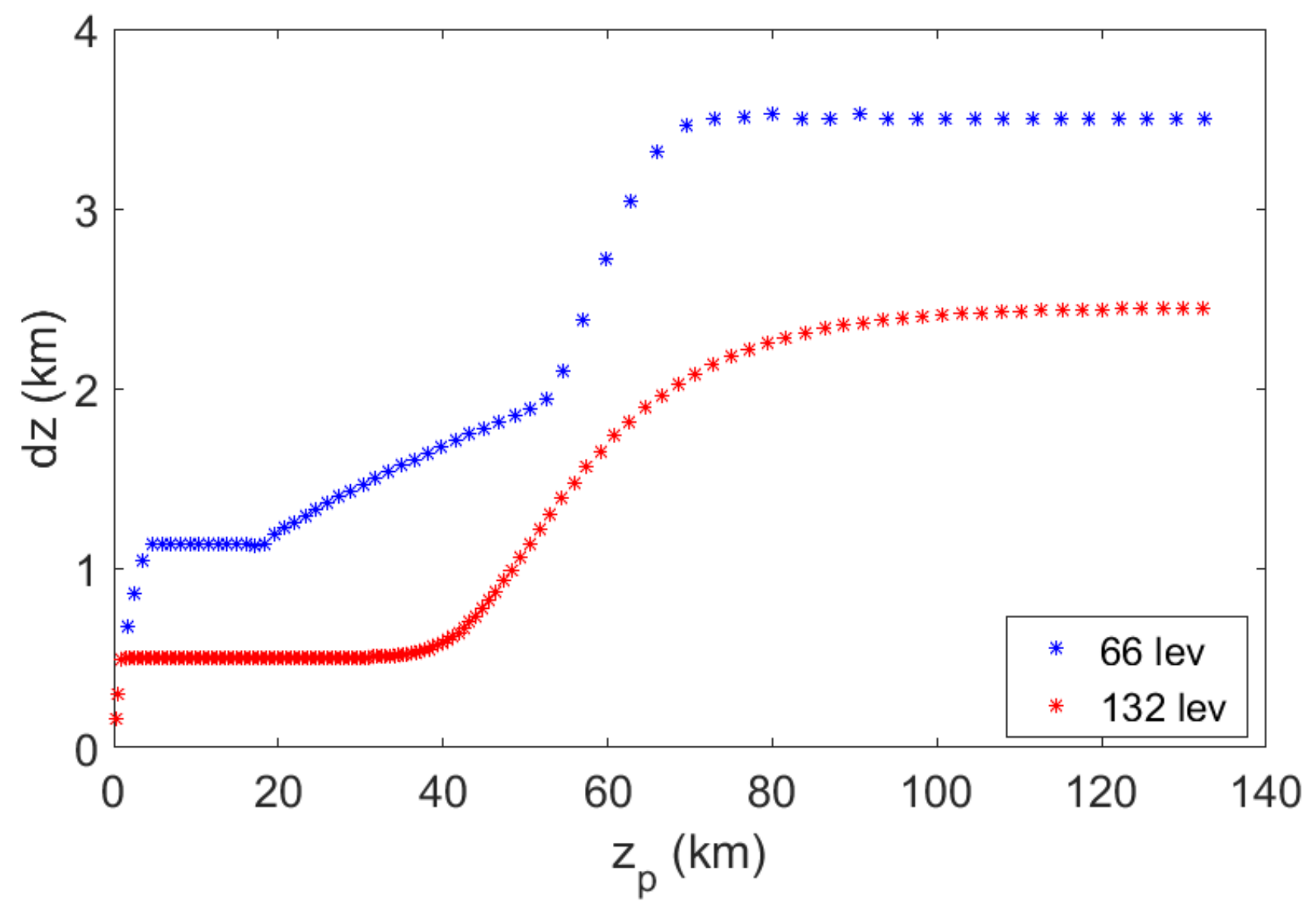
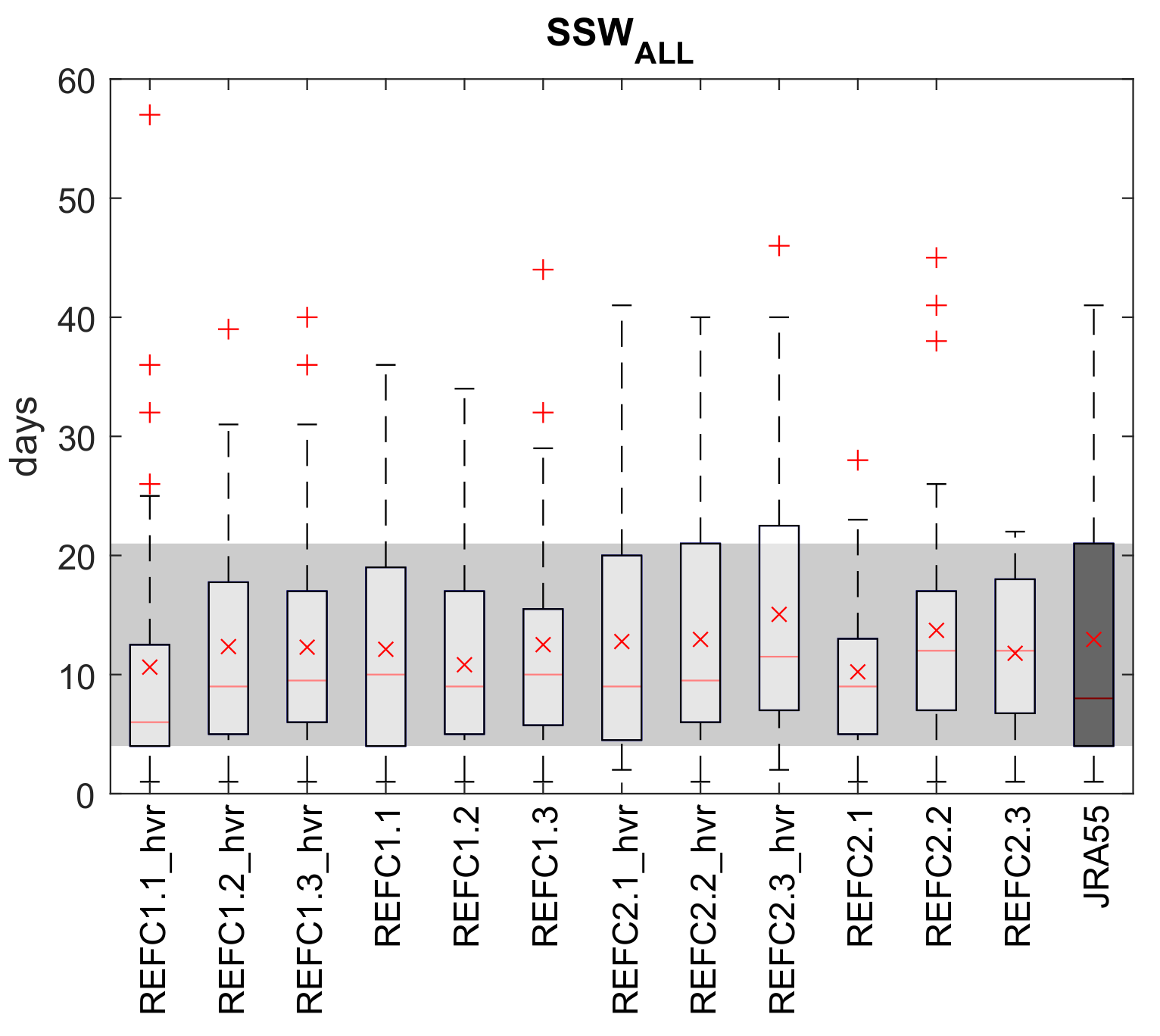
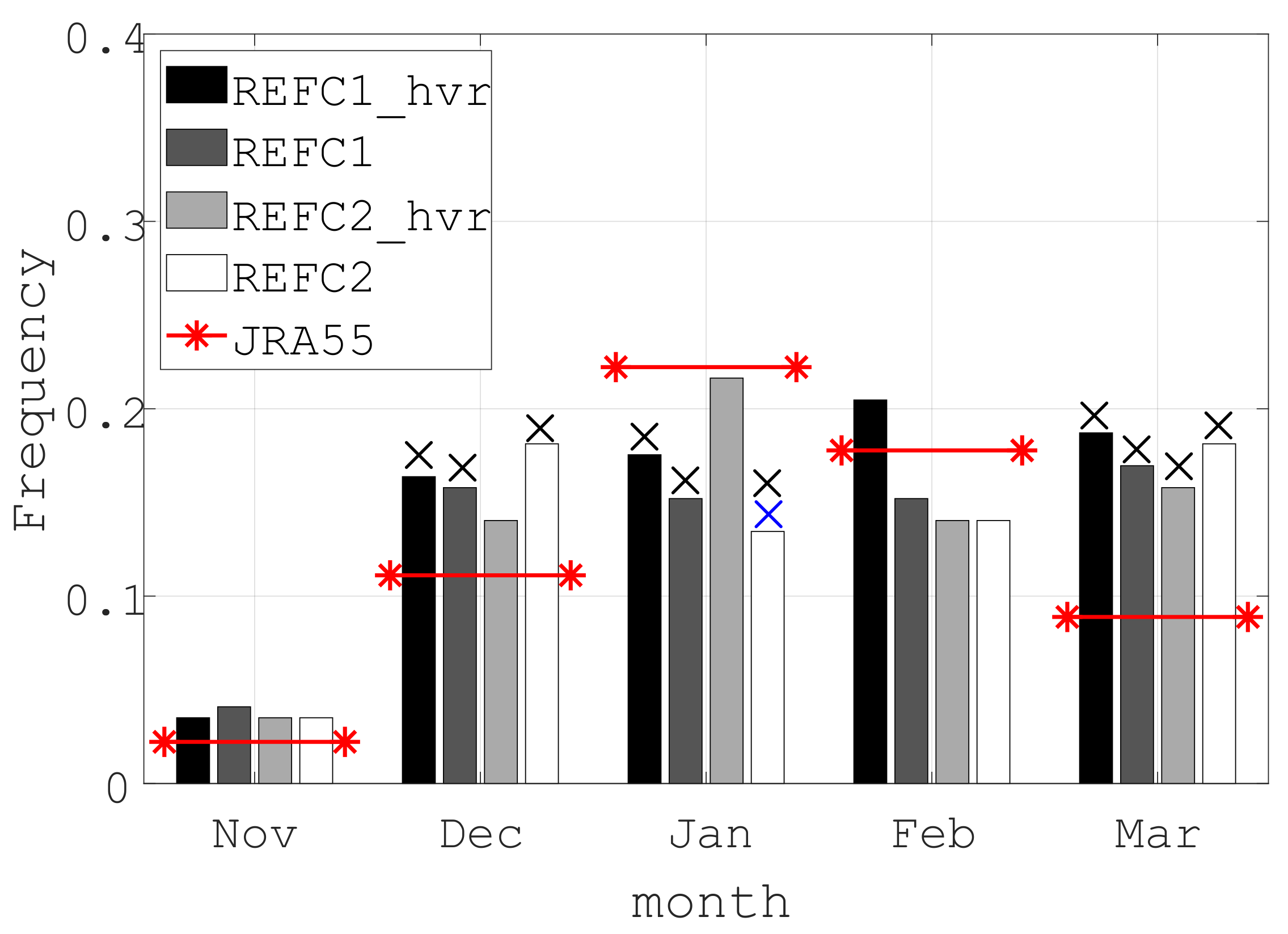

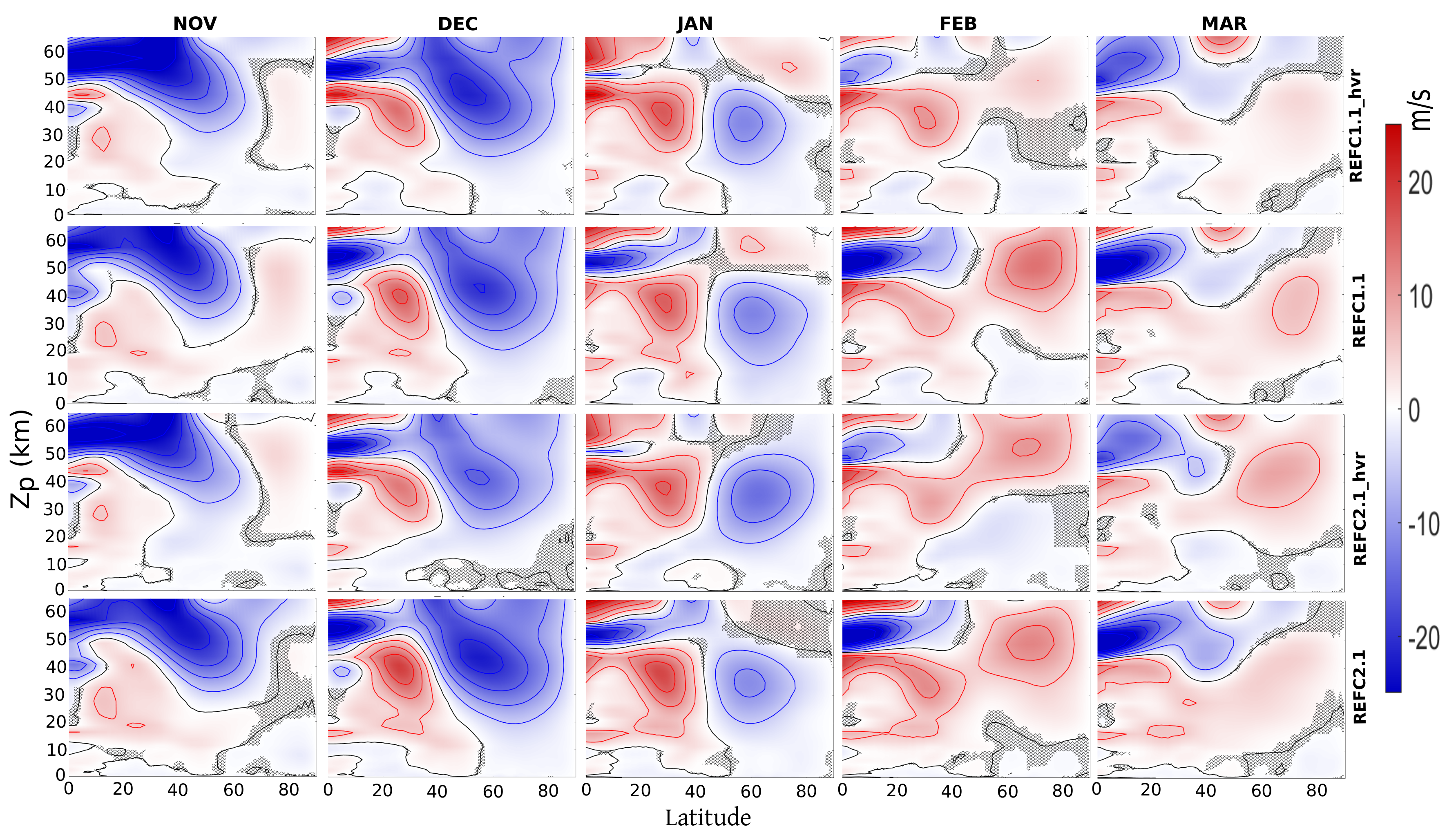
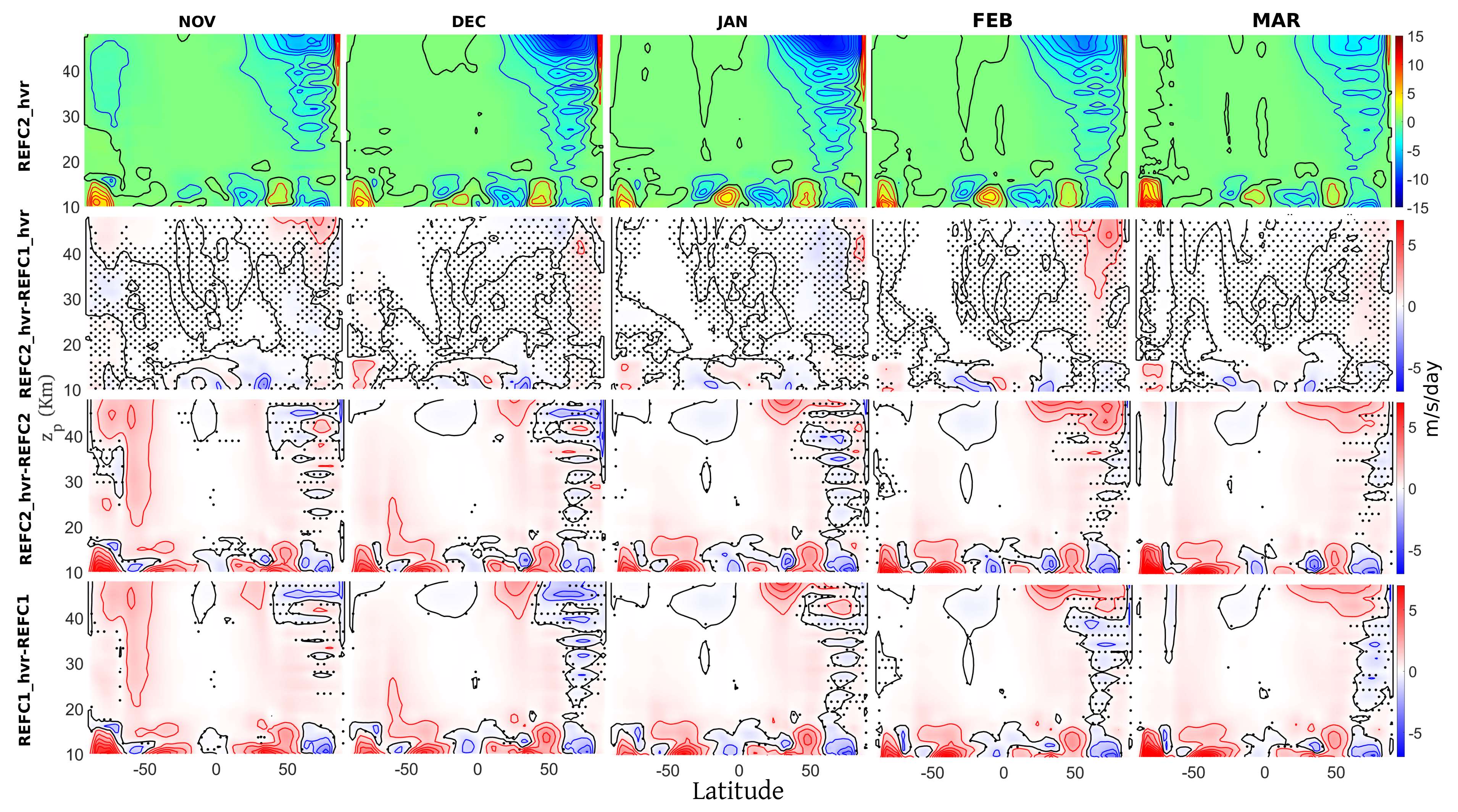
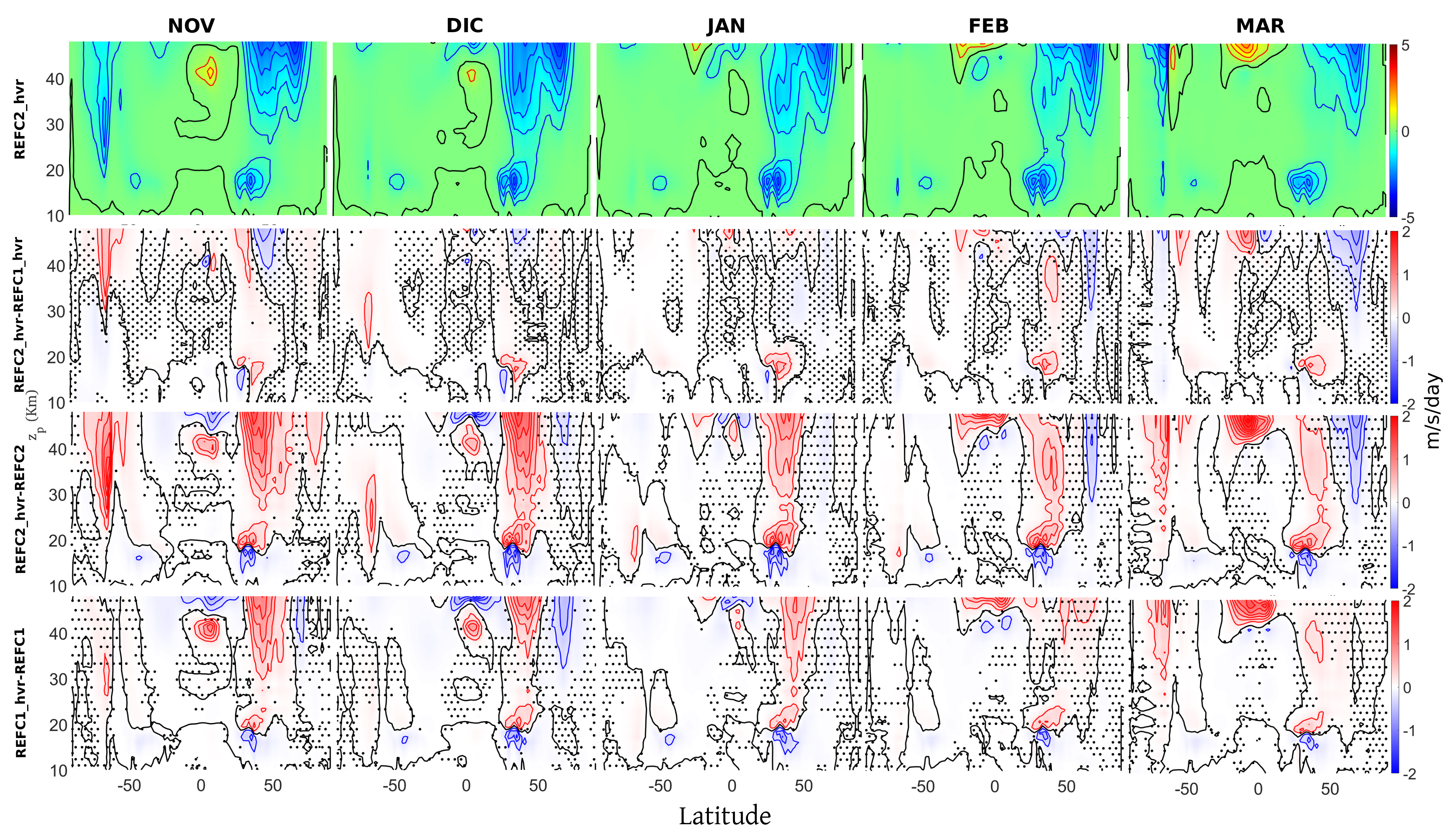
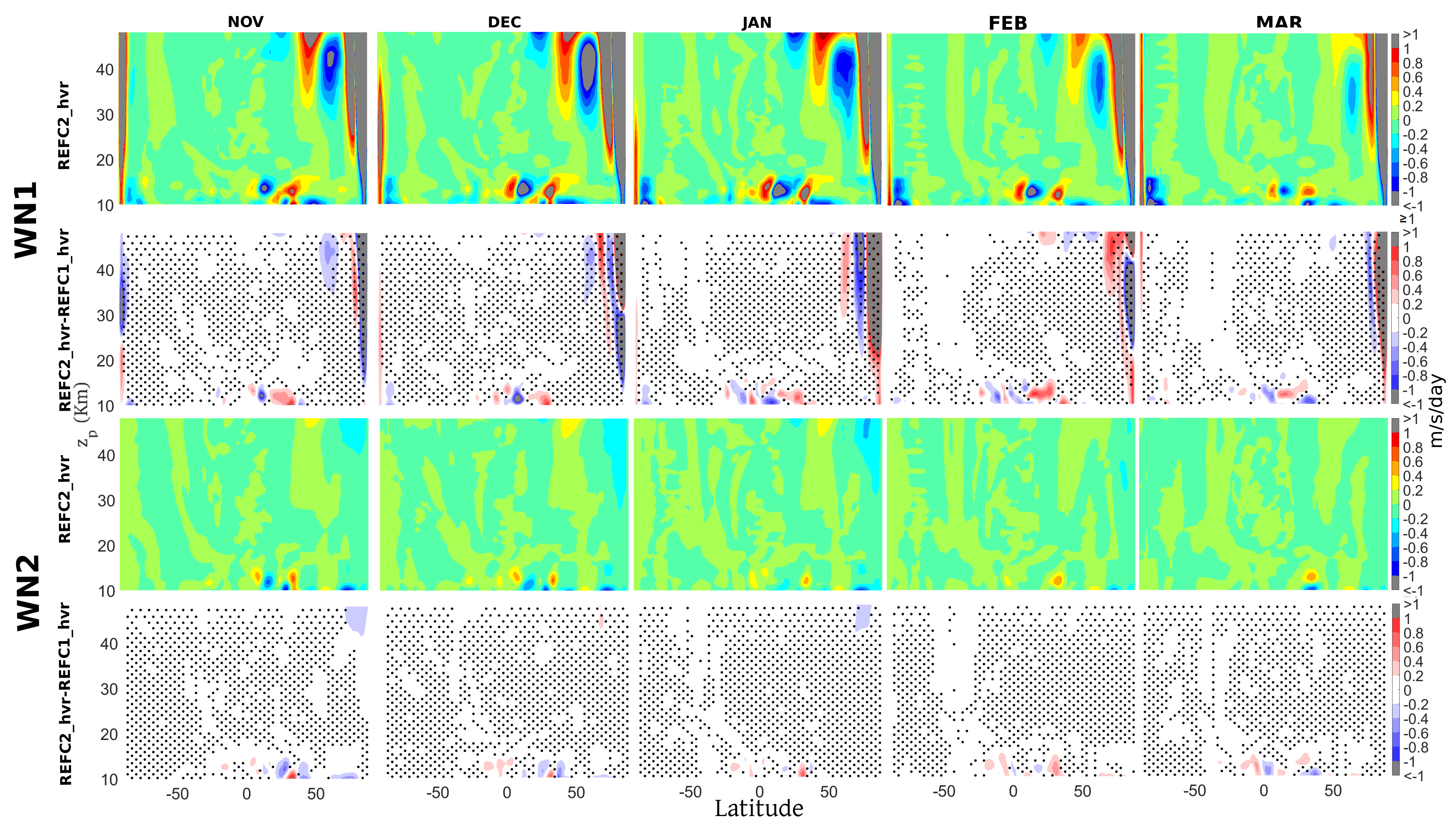
| Dataset | Total SSWs | SSWs/Winter | / |
|---|---|---|---|
| REFC1.1_hvr | 48 | 0.84 (0.07) | 2.69 |
| REFC1.2_hvr | 43 | 0.75 * (0.07) | 1.87 |
| REFC1.3_hvr | 40 | 0.70 * (0.08) | 1.85 |
| REFC1_hvr | 131 | 0.77 * (0.04) | 2.12 |
| REFC1.1 | 40 | 0.70 * (0.07) | 2.33 |
| REFC1.2 | 34 | 0.60 * (0.07) | 2.78 |
| REFC1.3 | 41 | 0.72 * (0.08) | 1.93 |
| REFC1 | 115 | 0.67 †* (0.04) | 2.29 † |
| REFC2.1_hvr | 40 | 0.70 * (0.09) | 7.00 |
| REFC2.2_hvr | 42 | 0.74 * (0.09) | 3.67 |
| REFC2.3_hvr | 36 | 0.63 * (0.06) | 3.50 |
| REFC2_hvr | 118 | 0.69 * (0.04) | 4.36 |
| REFC2.1 | 44 | 0.77 * (0.09) | 3.40 |
| REFC2.2 | 38 | 0.67 * (0.07) | 3.75 |
| REFC2.3 | 33 | 0.58 * (0.06) | 3.71 |
| REFC2 | 115 | 0.67 †* (0.04) | 3.60 † |
| JRA55 | 37 | 0.65 | 0.68 |
Publisher’s Note: MDPI stays neutral with regard to jurisdictional claims in published maps and institutional affiliations. |
© 2022 by the authors. Licensee MDPI, Basel, Switzerland. This article is an open access article distributed under the terms and conditions of the Creative Commons Attribution (CC BY) license (https://creativecommons.org/licenses/by/4.0/).
Share and Cite
Chávez, V.M.; Añel, J.A.; Garcia, R.R.; Šácha, P.; Torre, L.d.l. Impact of Increased Vertical Resolution in WACCM on the Climatology of Major Sudden Stratospheric Warmings. Atmosphere 2022, 13, 546. https://doi.org/10.3390/atmos13040546
Chávez VM, Añel JA, Garcia RR, Šácha P, Torre Ldl. Impact of Increased Vertical Resolution in WACCM on the Climatology of Major Sudden Stratospheric Warmings. Atmosphere. 2022; 13(4):546. https://doi.org/10.3390/atmos13040546
Chicago/Turabian StyleChávez, Víctor M., Juan A. Añel, Rolando R. Garcia, Petr Šácha, and Laura de la Torre. 2022. "Impact of Increased Vertical Resolution in WACCM on the Climatology of Major Sudden Stratospheric Warmings" Atmosphere 13, no. 4: 546. https://doi.org/10.3390/atmos13040546
APA StyleChávez, V. M., Añel, J. A., Garcia, R. R., Šácha, P., & Torre, L. d. l. (2022). Impact of Increased Vertical Resolution in WACCM on the Climatology of Major Sudden Stratospheric Warmings. Atmosphere, 13(4), 546. https://doi.org/10.3390/atmos13040546







